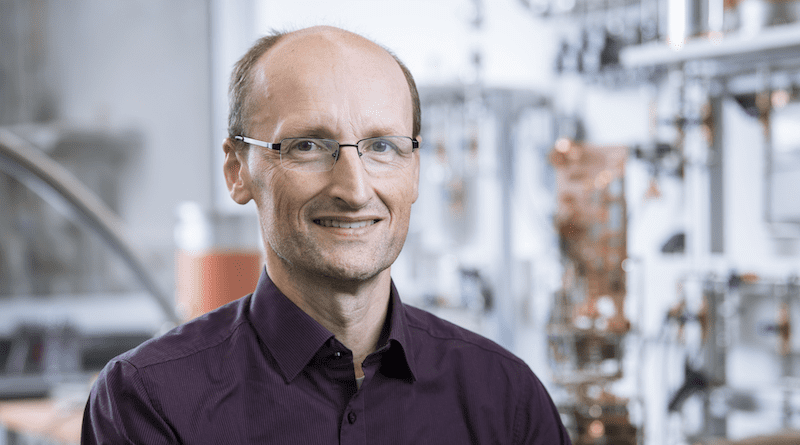Quantum Technology: Exploring Dark Matter
It permeates our universe and poses major challenges to research: Dark matter. As it does not emit any light nor any other kind of electromagnetic radiation, it remains invisible. Although dark matter is evident in many astrophysical and cosmological observations, its particle physics is still unclear.
According to a convincing hypothesis, dark matter consists of very light axions which interact weakly with ordinary matter. They are as-yet-hypothetical elementary particles of low mass. Within a strong electromagnetic field, the hypothesis suggests, axions can convert into electromagnetic waves and vice versa. In theory, there is every indication for axions as dark matter candidates. However, their existence has yet to be proven by experiment.
Quantum-based Haloscopes Search for Axions
The European DarkQuantum project searches for axions and is aiming at proving their existence. Professor Wolfgang Wernsdorfer of KIT`s Physikalisches Institut (PHI) is one of the lead researchers in the project, which is funded by the European Research Council with a Synergy Grant.
“The nature of quantum phenomena is one of the great, unsolved and therefore particularly fascinating issues in research. I am delighted that Wolfgang Wernsdorfer and his colleagues in Germany and abroad have been able to jointly acquire one of the prestigious ERC Synergy Grants,” says Professor Oliver Kraft, Acting President of KIT.
DarkQuantum uses quantum technology and combines it with particle physics infrastructures at CERN and at DESY in order to detect axions in the galactic halo, which is the exterior part of the Milky Way. Superconducting qubits enable the design of instruments that are extremely sensitive to tiny amounts of electromagnetic radiation, with much lower background noise than conventional technologies. The plan is to build two quantum-based haloscopes. These sensors will be able to detect axions through their interaction with electromagnetic fields with unprecedented sensitivity and range.
Proof Would Profoundly Change our Understanding of Reality
“The axion haloscopes are equipped with a cooled vacuum chamber, in which a strong magnetic field is generated. In this cavity, axions should be converted into photons. The resulting oscillations in the electromagnetic field can be recorded by highly sensitive detectors,” Professor Wernsdorfer explains.
The construction of quantum-based instruments for particle physics requires close cooperation between experts from very different fields in physics, from ultra-low temperature cryogenics to quantum circuits and particle physics.
“If the DarkQuantum project’s new strategies succeed in proving axions experimentally, this would be a breakthrough in physics that would have a fundamental impact on our understanding of reality,” Wolfgang Wernsdorfer says.
A total of eight European universities and research institutes are involved in the DarkQuantum project. The Universidad de Zaragoza/Spain acts as coordinator; the leading researchers come from there as well as from KIT, the National Centre for Scientific Research (CNRS) in France and the University of Aalto in Finland. The project is designed to run for six years. The funding amounts to 12.9 million euros, of which KIT will receive around two million.

